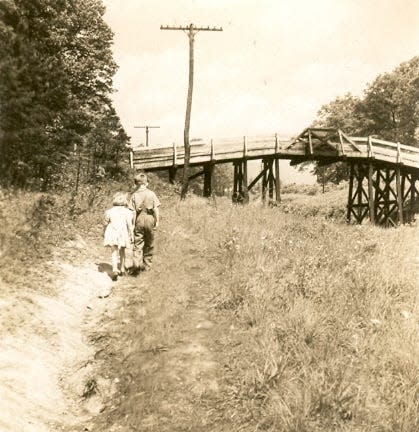Visiting Our Past: Trains, reservoirs and a protective patrolman figure in Oakley memories

"My son was a train enthusiast," 91-year-old Rae Roberts says of Dale Roberts, recalling when Dale was a toddler in Oakley in the early 1940s. When he heard a whistle from afar, she relates, "he would go to the dining room windows, and he would say, 'Here comes number ...' and he would name it. They were steam engines then, and the numbers on them were real big. And when they got here, he was right every time."
When Dale began helping his older sister with her singing lessons, Rae started suspecting he had perfect pitch. "I put him in that room," she told Joshua Hubing-Cooper, a Warren Wilson College student who recently interviewed her, "and I hit notes on the piano, and he could tell what they were. ... He went to Furman (University for his bachelor's degree), and they called him P.P.," for perfect pitch.
Dale Roberts taught for many years as assistant professor emeritus of music at Converse College in Spartanburg, S.C., before his death on April 29, 2004. The alumni bulletin noted, "For many years, he was first oboist with the Greater Spartanburg Philharmonic Orchestra. His lifelong hobby was steam locomotives of the Southern Railway."
The train is also prominent in the memory of Mike Miller, Oakley native and owner of Town and Mountain Realty in Asheville. When he was 13 years old, he and his brother rode their horses to Pressley's Feed and Seed Store (on a site behind present-day Home Depot). The boys helped unload the hay that came by rail to the store yard.
"We'd get on our horses and ride through the woods, and we'd go up Lover's Loop Road, and then hit the (Blue Ridge) Parkway. This was after hours, when all the workers had left for the day." The section of parkway between U.S. 70 and Brevard Road had been the last piece to be constructed, except for the Linn Cove Viaduct at Grandfather Mountain.
Miller recalls riding up to the Upper Reservoir, now called Busbee Reservoir, getting through gaps in fences and riding all over property owned by the Biltmore Co. "We'd ride on these logging roads," Miller recounted to Rebecca Williams, oral historian, "and we would skinny-dip in that upper reservoir. It was very small and very deep."
A dilapidated gatehouse confronted the boys. "You could get in that gatehouse," Miller noted, "and walk around the holes in the floor, and where there had been a window, you could dive into the reservoir. It was a neat thing for boys that age, growing up; and we watched the parkway getting completed."
Hubing-Cooper and Williams were two of several people involved in a collaboration between Jerry Pope's community arts class at Warren Wilson College and Together We Read. The class and Williams met with nine Oakley residents in preparation for a presentation of student interpretations at Oakley Community Center on Monday.
Whereas historians' views of the past take the forms of dramatic stories and connective themes, history as recollected by individuals often involves a different kind of lens — one that reveals a constellation of vivid memories, not necessarily in story form.
For example, one of the almost mythological particulars in Roberts' life is the former bridge that had connected Oakley with the Sayles-Biltmore Bleachery. It was made of wood and had allowed only one car to cross over the railroad at a time. Every 10 years, Roberts says, the bleachery closed the bridge to traffic to maintain the private status of the road.
"You go through the woods there," Roberts says, visiting her past. "There were no houses, just woods on each side, and it was kind of scary sometimes. But they had a patrolman who would come over there every day and see that the children got to school, and nothing happened to them. That's one of the memories I have."
An image of the woods through which Scout Finch walked in her ham costume in "To Kill a Mockingbird" comes to mind. But unlike Scout, Roberts had never been attacked; the drama stayed contained in a feeling.

Rob Neufeld wrotes the local history feature, "Visiting Our Past," for the Citizen Times until his death in 2019. This column originally was published Dec. 10, 2008.
This article originally appeared on Asheville Citizen Times: Visiting Our Past: Trains, reservoirs, protective patrolman in Oakley

